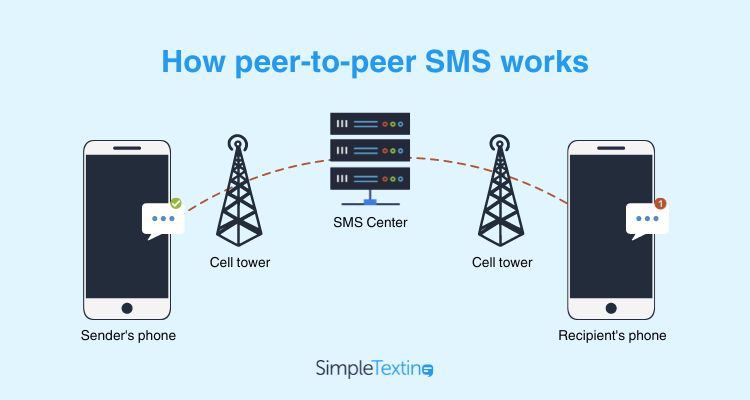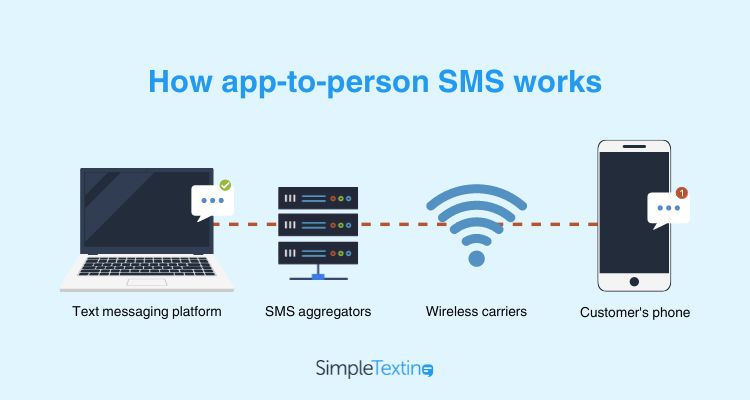How SMS Works for Text Message Marketing
Learn how SMS works for text messages and how it moves through cell towers, aggregators, and wireless networks to reach your recipients.
When you send a letter in the mail, it flows through an intricate network of post offices, sorting facilities, and distribution centers.
Then, almost like magic, it appears in your recipient’s mailbox a few days later.
SMS messages follow a similar process, but digitized. Instead of transporting directly to your recipient’s phone, the text bounces between a series of checkpoints instantly.
Not only do those checkpoints move your text’s data from one device to the other, but they also help protect people from spam and fraudulent messages.
Let’s dive into how SMS messaging technology works for texting friends, family, and customers.
What is SMS Messaging?
SMS, which stands for Short Message Service, is a way to send concise text messages between mobile phones.
When SMS was first introduced in 1992, mobile networks had limited capacity to transmit data, so the messages needed to be short (160 characters or fewer) to conserve network resources. Thanks to advancements in texting technology, we can now use extended SMS messages to send more than 160 characters into one text.
If you want to send even longer text messages to your customers, you can use MMS messaging, which allows up to 1,600 characters and media (like images, videos, audio, GIFs, and PDFs).
How Does SMS Work?
There are two ways to send SMS messages: peer to peer texting (P2P messaging) and application-to-person (A2P) messaging. Both deliver text messages to mobile devices, but they take different routes to get there.
The Journey of a P2P Message
Let’s say you want to text a friend that you’re running late for dinner. You type up the message, “Hello! Sorry, I’m running late. Be there in 10.”
Here’s how your message reaches your friend:

Step 1: Convert the Text into the GSM 7-bit Alphabet
First, your phone converts your message into the GSM 7-bit alphabet, which breaks your text up into the tiniest bits of data that can be transmitted to a cell tower.
This includes your message and some basic information about it, like its timestamp and the recipient’s phone number.
Step 2: Send the Text to a Short Message Service Center via a Cell Tower
Your phone sends the tiny message to a nearby cell tower. Once the cell tower receives your message, it sends it to a system called the Short Message Service Center (SMSC).
Step 3: The SMSC Sends the Text to a Cell Tower Near Your Friend
The SMSC checks who your friend — the recipient — is and then checks if they are in range. If they are, the message is then sent to the tower nearest to them and then, finally, their mobile phone.
Step 4: Your Friend’s Phone Converts the Text to Your Original Message
Your friend’s phone then turns the messages back from the GSM 7-bit alphabet into standard English characters by using the same code, but in reverse.
If the SMSC can’t find the phone, the message will just bounce around in its system until the moment the phone reconnects, at which point it sends it immediately.
The Journey of an A2P Message
If you’re sending SMS messages from an SMS marketing platform (like SimpleTexting), your text takes a different path to get to your customers’ phones.
Whether you’re sending a mass text message or a two-way message, the sending process is the same:

Step 1: Compose the Text in Your A2P Messaging Provider
Use an A2P messaging provider to compose the text message you want to send. You can send the message right away or schedule it for later. Your A2P provider also monitors messages for prohibited content.
Step 2: The A2P Messaging Provider Sends the Text to an Aggregator
Next, your A2P messaging provider sends the message to an aggregator (also known as an SMS gateway). The aggregator acts as a middleman between the A2P provider and the wireless carriers and helps prevent spam messages from reaching the carriers’ networks.
Step 3: The Aggregator Sends the Text to Your Contacts’ Wireless Carriers
The aggregator receives the text message from the A2P provider and forwards it to the wireless carriers that are associated with the recipients’ mobile phone numbers.
Step 4: The Wireless Carriers Send the Text to Your Contacts
After receiving the text message from the aggregator, the wireless carriers responsible for the recipients’ phone numbers deliver the message to their respective devices. The message then appears as a regular SMS on the recipients’ phones, allowing them to read and respond to it.
SMS FAQs
What is the difference between a text message and an SMS message?
How do you use SMS texting?
Does SMS require internet?
How do text messages travel through the air?
These signals are then picked up by cell towers or base stations, which relay the message to the recipient’s cellular network. The recipient’s phone receives the radio signals, converts them back into text, and displays the message.
What technology is used in SMS?
How is SMS different from MMS?
How is SMS different from OTT?
This article was originally written on January 19, 2021, by Drew Wilkinson. It was refreshed and repurposed on July 12, 2023, by Dani Henion.